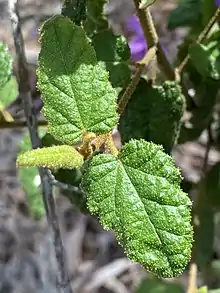Howittia
Howittia is a genus of plant containing the single species, Howittia trilocularis, commonly known as blue howittia,[3] and is endemic to Australia. It is a tall shrub found growing in shaded valleys and on rainforest edges, it has hairy leaves and single, purple flowers.
| Howittia | |
|---|---|
 | |
| Howittia trilocularis | |
| Scientific classification | |
| Kingdom: | Plantae |
| Clade: | Tracheophytes |
| Clade: | Angiosperms |
| Clade: | Eudicots |
| Clade: | Rosids |
| Order: | Malvales |
| Family: | Malvaceae |
| Subfamily: | Malvoideae |
| Genus: | Howittia F.Muell.[1] |
| Species: | H. trilocularis |
| Binomial name | |
| Howittia trilocularis F.Muell.[2] | |

Description
Howittia trilocularis is a spreading shrub up to 3 m (9.8 ft) high with oval to oblong-oval shaped leaves, 2.5–12 cm (0.98–4.72 in) long and 1.5–8 cm (0.59–3.15 in) wide, margins smooth, scalloped or slightly lobed. The under surface pale, white, yellow or brownish, irregularly covered with rusty or whitish star-shaped hairs, upper surface dark green. The whitish, lavender or deep mauve flowers are borne singly in the leaf axils, on a peduncle 3–4 cm (1.2–1.6 in) long and densely covered with long, matted hairs. The flowers have five petals, 1–2.5 cm (0.39–0.98 in) long on a pedicels 1.5–5 cm (0.59–1.97 in) long and yellow stamens. The calyx lobes are sharply pointed, 6–10 mm (0.24–0.39 in) long, rusty coloured with soft, star-shaped hairs. The seed capsule is rounded or indented globular shaped, 5–10 mm (0.20–0.39 in) in diameter and covered with soft, silky or star-shaped hairs. Flowering occurs from September to January.[3][4]
Taxonomy
Howittia trilocularis was first formally described in 1855 by Ferdinand von Mueller and the description was published in Definitions of rare or hitherto undescribed Australian plants from the type specimen which was found growing on "bushy declivities around Lake King".[5][6] The genus was named after Godfrey Howitt, a Melbourne physician, in recognition of his work as an amateur botanist. The specific epithet (trilocularis) means "having three locules.[3][7]
Distribution
It is found growing in sheltered gullies, rainforest margins and eucalypt forests in New South Wales, Victoria and South Australia.[3][8]
References
- "Howittia". Australian Plant Census. Retrieved 20 November 2020.
- "Howittia trilocularis". Australian Plant Census. Retrieved 20 November 2020.
- "Howittia trilocularis". eFloraSA-Electronic Flora of South Australia. State Herbarium of South Australia. Retrieved 20 November 2020.
- "Howittia trilocularis". VICFLORA-Flora of Victoria. Royal Botanic Gardens Victoria.
- "Howittia trilocularis". Australian Plant Name Index. Retrieved 25 November 2020.
- von Mueller, Ferdinand (1855). Definitions of rare or hitherto undescribed Australian plants. Melbourne: Goodhugh & Tembath. p. 38.
- Sharr, Francis Aubi; George, Alex (2019). Western Australian Plant Names and Their Meanings (3rd ed.). Kardinya, WA: Four Gables Press. p. 327. ISBN 9780958034180.
- Fairley, Alan; Moore, Philip (2010). Native Plants of the Sydney Region. Sydney: Jacana Books. p. 88. ISBN 9781741755718.